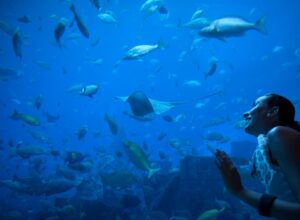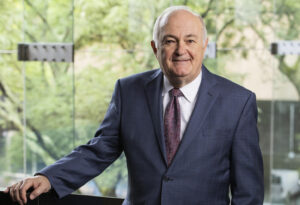Writer: Eleana Teran
 2 min read January 2023 – Pittsburgh attracts a great deal of tourists because of its unique offerings in the arts and culture space, including world-class exhibitions and programming, outdoor spaces and recreational opportunities — making Pittsburgh and Southwest Pennsylvania a popular destination for visitors. Steven Knapp, president and CEO of the Carnegie Museums of Pittsburgh, and Jeremy Goodman, president and CEO of the Pittsburgh Zoo & PPG Aquariums, shared their thoughts with Invest: on the importance of their organizations in the region’s continued growth.
2 min read January 2023 – Pittsburgh attracts a great deal of tourists because of its unique offerings in the arts and culture space, including world-class exhibitions and programming, outdoor spaces and recreational opportunities — making Pittsburgh and Southwest Pennsylvania a popular destination for visitors. Steven Knapp, president and CEO of the Carnegie Museums of Pittsburgh, and Jeremy Goodman, president and CEO of the Pittsburgh Zoo & PPG Aquariums, shared their thoughts with Invest: on the importance of their organizations in the region’s continued growth.
What were the most significant highlights and milestones for your organization over the past year?
Steven Knapp
This past year has been amazing for us because so much happened. The Andy Warhol Museum opened The Pop District, which is a creative placemaking project on the North Shore of Pittsburgh. It has several components. Next door to the museum, we’re running a workforce development initiative that provides training for local students in fields like digital marketing, and we offer certificates for the skill sets needed in today’s digital economy, many of which are related to Andy Warhol’s legacy as a real innovator in many different media.
We’ve purchased the parking lot across the street from The Andy Warhol Museum — a surface lot on which we’re going to build a four-story building that will include a concert venue that doesn’t have a parallel in our city at this point. It’ll be around an 800-seat capacity space that will bring some of the musical acts that we currently don’t attract to Pittsburgh. It’s very unusual for a museum to be involved in a project like this and we’re excited about it.
Last fall, our Science Center hosted the national conference of ASTC, the Association of Science and Technology Centers. We brought 1,400 leaders of institutions from around the country to this event, and it was an opportunity to promote Pittsburgh as a center for science and innovation. Additionally, we opened the 58th Carnegie International at the Carnegie Museum of Art, bringing to Pittsburgh some 500 works by 100 artists from 40 countries. Lastly, in November, we launched the newest major exhibit at Carnegie Science Center, called Mars, The Next Giant Leap. This is an interesting project because its design and content were developed in partnership with the community.
 Jeremy Goodman
Jeremy Goodman
I would say our biggest priority this year has been to do a lot of listening. I’ve been very successful as far as turning zoos around multiple times in different states and there isn’t a secret recipe for doing it. You have to tailor the institution to the community. I’ve been trying to understand what it is that the community, the Western Pennsylvania community, the Pittsburgh community, is looking for, what they need in the zoo, what they need in the community and what other places are doing so we don’t have to duplicate where we can collaborate.
Over the last year, we’ve also made great strides in fixing our aging infrastructure. A lot of our buildings are starting to age and we made a significant investment over the last year to make some major repairs throughout the zoo, which might not get noticed by the general public but are incredibly important. They don’t notice when you replace the roof but they notice when the roof leaks.
We’ve also completed a new five-year strategic plan for the zoo, which is exciting, and we are moving toward the beginning stages of our new physical facility master plan, a 20-year plan that will be the blueprint of our physical campus here in Pittsburgh.
How would you describe the organization’s economic impact in the greater Pittsburgh region?
Knapp: I would say it’s a substantial impact. We have 1,000 employees to begin with and we do a lot of contracting with all kinds of partners. We are educating in one way or another about 250,000 students a year, either directly with on-site programs or with various kinds of outreach. There is also a great impact through the economic activity we support for hotels and the food service industry; for instance, we serve food at all our venues, which host hundreds of events each year. So, it’s many different kinds of economic and educational impacts. Finally, we greatly impact the quality of life here, which we believe contributes to talent and new-business recruitment.
Goodman: We are by far the No. 1 tourist destination in the region. The average is about a million visitors a year and that is far and away larger than any other paid attraction in the region and it’s something that we’re proud of. We want to make sure as a mission-driven organization that we always remain accessible to everybody, but yet we are a business, and we have to make sure that the bills get paid and then we have the revenue streams to ensure that we are fulfilling our mission.
The economic impact is a little over $80 million annually and the zoo is known for often getting the youth of Pittsburgh their first employment opportunities, which I think is great. It’s a great thing to put on your resume and it is certainly eye-catching when you’re applying to colleges and things like that. It’s a topic of discussion and I think those kids learn some good business habits as far as excellent customer service.
How do you make the museums more accessible to people with disabilities?
Knapp: Our museums offer a number of options for people with physical and cognitive challenges. We have some touchable exhibitions of Warhol’s works so that people who have visual impairments can have a tactile experience of engaging with the works. We do the same at the Science Center. We have special programming and times set aside to welcome people with sensory sensitivity. We’ve even hosted silent discos, with headphones through which you can hear the music, but it’s not blasting through the halls. There are a lot of options for people with disabilities.
We’re also proud to be offering three Community Access Memberships that aim to make our museums more accessible to people of all ages, particularly those who may be economically disadvantaged. They include a free Teen Membership, which has already signed up nearly 13,000 young people; a new Family Access Membership, which has already welcomed more than 3,600 families to our membership ranks at the low cost of $20, as opposed to $150; and a special Organizational Outreach Membership through which community nonprofits can bring their clients to the museums for free all year long
How is the zoo leveraging technological capabilities or innovation?
Goodman: We’re looking at potentially incorporating things like virtual keepers and augmented reality. We brought in virtual reality this year, a virtual reality experience where people feel like they’re right in the middle of a mountain gorilla troop. It’s all educational but it’s what this generation is looking for.
I will say you can never really replace live animals. Other people have said that with virtual reality and augmented reality, why do you need to have animals here? I’ve seen people wear virtual reality goggles and high-def images of elephants and giraffes but when you are standing face to face with just such an impressive, incredible creature like that, it’s just life-changing. You just can’t get that virtually.
What is your outlook for your organization and the overall cultural sector in Greater Pittsburgh?
Knapp: We just finished a strategic visioning process that lays out three overarching objectives for the next three to five years: supporting our staff, accelerating the development of innovative programs, and engaging the communities we serve in partnership with those communities themselves. That last objective is shared these days by many arts and cultural institutions, in part as a response to the social and economic disparities that were highlighted by the pandemic. One program we’ve already launched is our summer “Inside Out” concert series, in which the Museum of Art brings local artists – DJs on Thursdays, live performers on Saturdays – to its Sculpture Courtyard. We were created by Andrew Carnegie as a gift to the people of greater Pittsburgh, and that’s just one example of how we are continuing to demonstrate what it means to be a true community asset.
Goodman: I’m excited about the outlook for the zoo. I think we’re at a critical turning point right now in the zoo’s history. Our zoo, with all of our strategic planning and our master planning, is in a critical moment now where we’re going to be defining our future over the next couple of years.
Overall, the outlook for tourism is on the upswing. I think there’s a long way to go quite honestly before we get recognized regularly as that must-see tourist city but the zoo is committed to helping that move along. The future is bright.
For more information, please visit:
